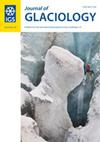A method to estimate surface mass-balance in glacier accumulation areas based on digital elevation models and submergence velocities
IF 2.6
3区 地球科学
Q2 GEOGRAPHY, PHYSICAL
引用次数: 0
Abstract
Measuring surface mass-balance in the accumulation areas of glaciers is challenging because of the high spatial variability of snow accumulation and the difficulty of conducting annual field glaciological measurements. Here, we propose a method that can solve both these problems for many locations. Ground-penetrating radar measurements and firn cores extracted from a site in the French Alps were first used to reconstruct the topography of a buried end-of-summer snow horizon from a past year. Using these data and surface elevation observations from LiDAR and Global Navigation Satellite System instruments, we calculated the submergence velocities over the period between the buried horizon and more recent surface elevation observations. The differences between the changes in surface elevation and the submergence velocities were then used to calculate the annual surface mass-balances with an accuracy of ±0.34 m w.e. Assuming that the submergence velocities remain stable over several years, the surface mass-balance can be reconstructed for subsequent years from the differences in surface elevation alone. As opposed to the glaciological method that requires substantial fieldwork year after year to provide only point observations, this method, once submergence velocities have been calculated, requires only remote-sensing data to provide spatially distributed annual mass-balances in accumulation areas.基于数字高程模型和淹没速度估算冰川堆积区地表物质平衡的方法
测量冰川堆积区的表面质量平衡具有挑战性,因为积雪的空间变异性很高,而且难以进行年度实地冰川学测量。在这里,我们提出了一种方法,可以在许多地方解决这两个问题。探地雷达测量和从法国阿尔卑斯山的一个地点提取的冷杉岩心首次用于重建去年夏末雪层的地形。利用这些数据和激光雷达和全球导航卫星系统仪器的地表高程观测,我们计算了埋藏地平线和最近地表高程观测之间的一段时间内的淹没速度。然后,利用地表高程变化和淹没速度之间的差异来计算年地表质量平衡,精度为±0.34 m w.e。假设淹没速度在几年内保持稳定,则可以仅根据地表高程的差异重建随后几年的地表质量平衡。与冰川学方法不同的是,这种方法需要年复一年的大量实地调查,只提供点观测,一旦计算出淹没速度,这种方法只需要遥感数据,就可以在堆积区提供空间分布的年度质量平衡。
本文章由计算机程序翻译,如有差异,请以英文原文为准。
求助全文
约1分钟内获得全文
求助全文
来源期刊

Journal of Glaciology
地学-地球科学综合
CiteScore
5.80
自引率
14.70%
发文量
101
审稿时长
6 months
期刊介绍:
Journal of Glaciology publishes original scientific articles and letters in any aspect of glaciology- the study of ice. Studies of natural, artificial, and extraterrestrial ice and snow, as well as interactions between ice, snow and the atmospheric, oceanic and subglacial environment are all eligible. They may be based on field work, remote sensing, laboratory investigations, theoretical analysis or numerical modelling, or may report on newly developed glaciological instruments. Subjects covered recently in the Journal have included palaeoclimatology and the chemistry of the atmosphere as revealed in ice cores; theoretical and applied physics and chemistry of ice; the dynamics of glaciers and ice sheets, and changes in their extent and mass under climatic forcing; glacier energy balances at all scales; glacial landforms, and glaciers as geomorphic agents; snow science in all its aspects; ice as a host for surface and subglacial ecosystems; sea ice, icebergs and lake ice; and avalanche dynamics and other glacial hazards to human activity. Studies of permafrost and of ice in the Earth’s atmosphere are also within the domain of the Journal, as are interdisciplinary applications to engineering, biological, and social sciences, and studies in the history of glaciology.
 求助内容:
求助内容: 应助结果提醒方式:
应助结果提醒方式:


